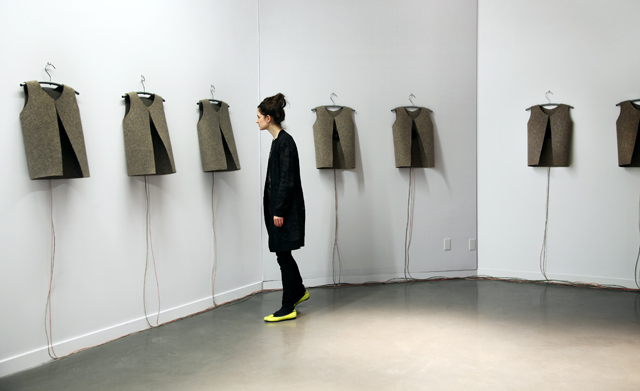Intuiting change is an opening gambit artists and scientists share. They follow the same fundamental trends: serendipity, pleasure and astonishment, coincidence and imagination, abstraction and reality –a revamping of traditional beliefs. So it is only natural that they team up to challenge ideas in research opening up perceptions of life, death and everything in between.
Running at Montreal’s Phi Center, the exhibition Hybrid Bodies: An Artistic Investigation into the Experience of Heart Transplantation is a demonstration of such unmitigated collaboration. Launched in 2010 by a committed trans-disciplinary research team, across cardiology, philosophy, nursing, psychiatry, and sociology, practitioners invited four artists to work on the emotional and psychological impact of heart transplants on recipients. In this case, the remarkable innovation lies with the scientists, knocking at the door of the art world and going beyond mere dilettantism, as pointed out by UK participant Andrew Carnie in The Observer in 2002:
“The practice of science is not isolated from the world we live in. Science has its politics, its economics, its fashions even. And anecdotally at least, some of the scientists involved in ‘sci-art’ collaborations report an intellectual engagement in them that goes further than personal enjoyment. It’s not just that it allows them to get out of their labs a bit more; it also seems to offer a different way of looking at their own work as scientists.”

To paraphrase anthropologist Marcel Mauss‘ concept of ‘gift exchange’, ‘hybridity’ is the distinction between the ‘self’ and the ‘other’, the fusion of elements that are ordinarily kept apart, into a reciprocal bond between giver and receiver. Canadian artist Ingrid Bachmann deals with this material and metaphorical hybridity by applying the major recurring themes of heart transplants to performance in the video ‘The Gift’ (2013). She asked two dancers to interpret the ambivalent relationship between a host and their guest; the heaviness of a dying heart and the lightness of a healthy one; the grasping reflex and its fight against transplant rejection. In her installation ‘A Part of Me’ (2013), bone transducer sensors are used to transmit testimonies of heart transplant recipients to the audience. The sound is conducted to the inner ear through the direct vibrations of the bones in the skull, giving us the sensation that the subject is being empowered to speak up with their innermost thoughts and sensations.
The depressive and anxiety-related disorders felt by post-transplant patients have also been traced back by UK artist Alexa Wright, in the interactive sound installation ‘Heart of the Matter’ (2013-2014). Intertwined with personal narratives of intimate relationships, the stories are activated on a viewer’s approach. The bigger the audience, the more overwhelming the cacophony of voices and indistinguishable distress there is. It becomes difficult to discern whether these people are arousing a physical or emotional response, as with the video projection ‘A Change of Heart’ (2012) by Carnie. Here he proposes a slow and absorbing iteration of a naked human body through unfolding narratives. His work is based on drawings made while listening to taped interviews of patients and it appears that no identity is fixed. An individual receiving a transplant may be part of another person, while remaining them selves: the single and indivisible human self is literally atomized by the putative presence of the other.
The breakthroughs of C.P. Snow are still alive then. In 1959, the scientist and fiction writer published The Two Cultures and the Scientific Revolution in which he denounced the idea that science and the humanities were not prone enough to communicate on a crossover basis. That’s why he advocated the creation of a ‘Third Culture’, dovetailing the two practices and allowing science to speak on humanistic concerns and vice versa. The recent failure to do so is currently being rectified, if this institutionalisation of the art-science connection and the development of dedicated training networks is anything to go by. That’s particularly when you consider the foundation of the French ‘Science, Art, Creation, Research’ (SACRe) PhD programme and the ArtScience lab network founded by David Edwards, author of Artscience: Creativity in the Post-Google Generation. They, like the organisers and participants of Hybrid Bodies, target the vibrant intermediate zone of creativity in both art and science and the fertile drive to diversity it is. **













